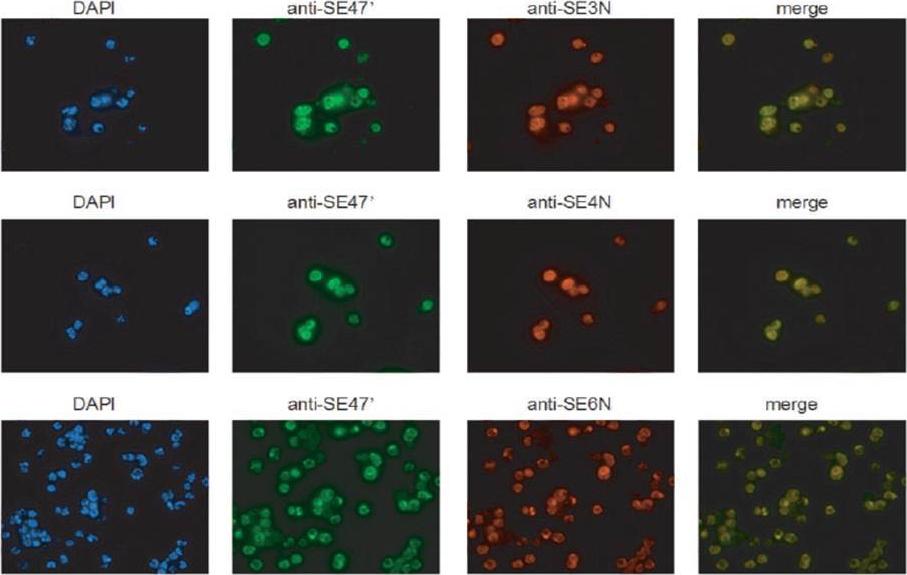PF3D7_0207700 serine repeat antigen 4 (SERA4)
Disruptability [+]
| Species | Disruptability | Reference | Submitter |
|---|---|---|---|
| P. falciparum 3D7 |
Possible |
17893128 | Theo Sanderson, Wellcome Trust Sanger Institute |
| P. falciparum 3D7 |
Possible |
USF piggyBac screen (Insert. mut.) | USF PiggyBac Screen |
Mutant phenotypes [+]
| Species | Stage | Phenotype | Reference | Submitter |
|---|---|---|---|---|
| P. falciparum 3D7 | Asexual |
No difference |
17893128 | Theo Sanderson, Wellcome Trust Sanger Institute |
Imaging data (from Malaria Metabolic Pathways)

SERA3–6 genes are expressed in single parasites at similar localization. Trophozoite- and schizont (Honduras-1)-infected erythrocytes were purified by Percoll and subjected to immunofluorescence staining with rabbit anti-SE3N, -SE4N, or -SE6N antiserum and mouse anti-SE47’ (SERA5) IgG. The secondary antibodies used were Cy3-conjugated anti-rabbit IgG and fluorescein isothiocyanate-conjugated anti-mouse IgG. 4’,6’-Diamidino-2-phenylindole was also used to stain parasite nuclei.Aoki S, Li J, Itagaki S, Okech BA, Egwang TG, Matsuoka H, Palacpac NM, Mitamura T, Horii T. Serine repeat antigen (SERA5) is predominantly expressed among the SERA multigene family of Plasmodium falciparum, and the acquired antibody titers correlate with serum inhibition of the parasite growth. J Biol Chem. 2002 277:47533-40.
See original on MMP
Peripherally associated proteins MSP3, MSP7, SERA4, and SERA5 are shed during invasion. Invading merozoites were labeled with PfRON4 as a marker of the tight junction (green) and colabeled with antibodies directed against MSP3 (A), MSP7 (B), SERA4 (C), or SERA5 (D). All proteins were shed at the point of tight junction, with antibody reactivity to the merozoite surface being observed only on the proportion of the merozoite external to the RBC. All primary antibodies were used at a 1:100 serum dilution, and secondary antibodies were used at a 1:500 dilution.Boyle MJ, Langer C, Chan JA, Hodder AN, Coppel RL, Anders RF, Beeson JG. Sequential processing of merozoite surface proteins during and after erythrocyte invasion by Plasmodium falciparum. Infect Immun. 2014 82(3):924-36.
See original on MMPMore information
| PlasmoDB | PF3D7_0207700 |
| GeneDB | PF3D7_0207700 |
| Malaria Metabolic Pathways | Localisation images Pathways mapped to |
| Previous ID(s) | PF02_0073, PFB0345c |
| Orthologs | PBANKA_0304800 , PBANKA_0304900 , PBANKA_0305000 , PBANKA_0305100 , PCHAS_0307000 , PCHAS_0307100 , PCHAS_0307200 , PCHAS_0307300 , PKNH_0413100 , PKNH_0413200 , PKNH_0413400 , PKNH_0413600 , PKNH_0413700 , PVP01_0416800 , PVP01_0416900 , PVP01_0417000 , PVP01_0417100 , PVP01_0417200 , PVP01_0417300 , PVP01_0417400 , PVP01_0417600 , PVP01_0417700 , PVP01_0417800 , PVP01_0417900 , PVX_003795 , PVX_003800 , PVX_003805 , PVX_003810 , PVX_003820 , PVX_003825 , PVX_003830 , PVX_003835 , PVX_003840 , PVX_003845 , PVX_003850 , PY17X_0305600 , PY17X_0305700 |
| Google Scholar | Search for all mentions of this gene |